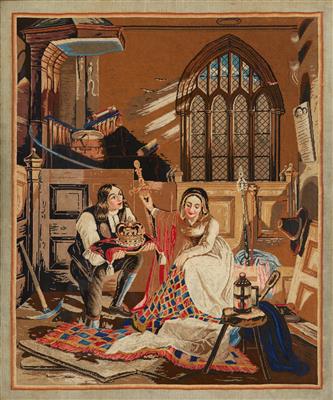Christian Grainger Hiding the Honours of Scotland
Download media
Object number20496
TitleChristian Grainger Hiding the Honours of Scotland
Creator Margaret L.M. Martin (sewer)
DescriptionThis tapestry was created in around 1850 by thirteen-year-old Margaret Martin. The 12,480 stiches are estimated to have taken her about 74 hours to complete. It is an amazing achievement which complements the incredible story that it portrays: a tale of suspense, concealment and treasure.
The tapestry is called Christian Grainger Hiding the Honours of Scotland. To set the scene: it is 1651, the monarchy has been deposed, King Charles I beheaded. Oliver Cromwell and his army have marched into Scotland and laid siege to Dunnottar Castle in Aberdeenshire. His aim is to capture the castle and destroy the Honours of Scotland – the Crown, Sceptre and Sword of State. The Scottish Parliament had ordered these precious objects to be moved to Dunnottar, home of their hereditary Keeper, the Earl Marischal.
The wife of the local minister, Reverend Grainger, has devised a plan to smuggle the Honours out of the castle and hide them inside the parish church. The tapestry captures the story at its nail-biting conclusion: the minister and his wife kneel before the pulpit in Kinneff Church in the dead of night. Their task is lit by a sole lantern, the fitful moonlight barely reaches the corners of the kirk. You can imagine their excitement at unwrapping these national treasures, their hurry to stow them safely under the floor.
The secret of the Honours was kept from Cromwell’s forces and they were returned to Edinburgh after the Restoration of Charles II in 1660. The epilogue to this tale is worthy of a romantic novel. Locked away after the Union of Parliaments in 1707, the Honours were rediscovered by Sir Walter Scott in 1818 in a locked chest, carefully preserved in linen. They were presented to King George IV on his triumphant visit to Edinburgh in 1822. Apart from a brief period during WW2, they have been on display in Edinburgh Castle ever since.
Production date 1845 - 1855
Production periodVictorian
SubjectKinneff Parish Church
Object nameTapestry
Materialwool/linen
TechniqueSewn
Dimensions
image Height: 615 mm
image Width: 504 mm
frame Height: 760 mm
frame Width: 656 mm
image Width: 504 mm
frame Height: 760 mm
frame Width: 656 mm

